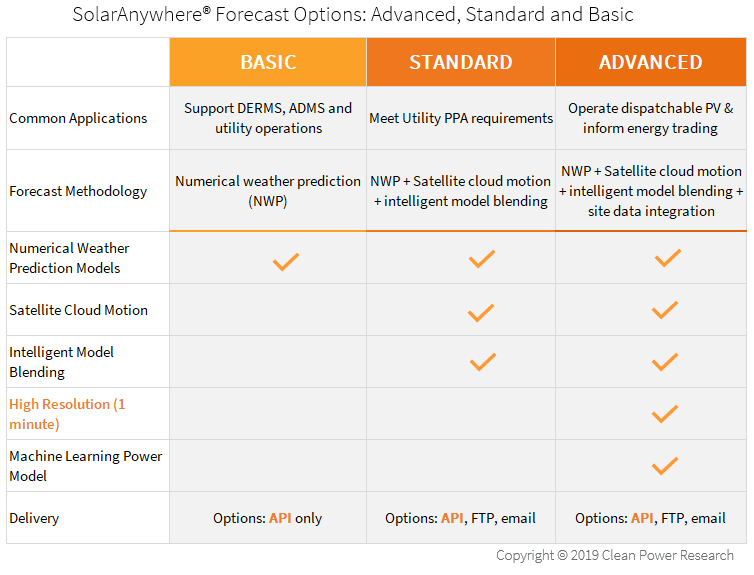Since 2014, compelling economics have made renewable energy the preferred source of new power generation capacity in the United States. Energy cost parity with traditional sources has been well-established by the International Renewable Energy Agency (IRENA) and other groups. Now, developers and utilities are increasingly concerned with transforming this clean, inexpensive energy into grid services and firm power—and solar forecasting plays a key role.
Examples making the news recently include virtual power plants, dispatchable PV, solar plus storage, and hybrid plants. The shifting focus from hardware and cheap energy to grid services is enabling renewable energy to supply a greater share of a reliable electric grid, compete head-to-head with traditional fossil generators and win.
As solar power has gained momentum, financing structures for new solar projects are evolving. Traditionally, renewable energy projects have been financed with multi-decade bulk energy power purchase agreements (PPAs). The prices paid for these contracts are plummeting. This is a result of falling costs and a recognition that after a certain point, additional unmanaged renewable energy has less value to offtakers. PPAs are getting shorter too, with generators willing to take on more merchant risk versus locking-in low returns. Some are de-risking non-contracted generation through innovative hedge vehicles such as derivatives, insurance or proxy revenue swaps. Other innovative PPAs give generators credit for firm capacity instead of just energy, which supports the development and financing of projects that support the grid.
The evolving landscape means solar power forecasting needs are becoming more varied and nuanced. For example, most utility-scale solar plants with traditional power purchase agreements are required to deliver day-ahead forecasts. Offtakers may use these forecasts to schedule generation resources appropriately. For the plant owner, a reliable forecast means avoiding penalties. But with solar plus storage or merchant plants, a highly accurate forecast can enhance the operation and profitability of the plant. Clearly, the requirements for solar forecasting services depends on the application.
New solar forecasting services for the next generation of PV
Clean Power Research and research partners at the University at Albany have long been leaders in solar forecasting and applying it to model firm power generation. In fact, Dr. Richard Perez has developed a valuation metric that quantifies forecast accuracy in terms of the storage needed to virtually eliminate forecast uncertainty and optimally lead to least-cost 24/7 firm power generation. A more accurate forecast can reduce the amount of storage required—and therefore the capital cost needed—to provide firm power with intermittent generation for a single plant or an entire balancing area.
To meet the varying needs of solar project owners, Clean Power Research is introducing three SolarAnywhere® Forecast options: Advanced, Standard and Basic. The options are designed to deliver the level of service demanded by specific applications.
SolarAnywhere Advanced Forecast
Clean Power Research is now giving independent power producers (IPPs) the tools to maximize the profitability of next generation solar power plants with the SolarAnywhere Advanced Forecast. Advanced Forecast customers take advantage of cutting-edge forecasting technology to optimize the operation of their solar plus storage assets.
The Advanced Forecast—with up to 1-minute resolution for 30-minutes ahead—informs real-time market decisions. A key challenge is correctly identifying the ramp-up and ramp-down events during days with variable weather conditions. By taking into account the predicted values in the nearest future, it’s possible to smooth PV plant production and transform intermittent renewable plants into firm generation.
What’s more, the power forecast can be improved when connected to the PV plant’s real-time data feed (e.g., SCADA output). We use this detailed data and apply machine learning to PV plant modeling. Machine learning techniques are superior to standard modeling approaches for simulating real-world conditions like shading, soiling, module degradation and plant availability. The result is an improvement on what was already the most accurate PV production forecast available.
SolarAnywhere Standard Forecast
Of course, transitions take time, and many valuable solar-only plants are coming online. For utility plant forecasting, SolarAnywhere continues to offer the Standard Forecast trusted by IPPs for its accuracy and reliability.
To meet PPA requirements, our customers need to deliver accurate forecasts to offtakers on time, every day of the year. Large portfolios with diverse contract requirements can be a challenge. SolarAnywhere Forecast makes it easy to deliver customized forecasts for each stakeholder, and manage them through a single, unified process.
SolarAnywhere Basic Forecast
Finally, there’s a Basic Forecast that can be used to cost-effectively operate DERs more intelligently, improve visibility into grid operation, or support any application under the sun. As with all or our forecast services, it’s easy to connect the SolarAnywhere API and start getting power and weather forecasts built for solar.
If you want to learn more about our new forecast offerings, please contact us or visit the SolarAnywhere Forecast Services page for more details.

